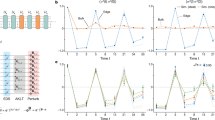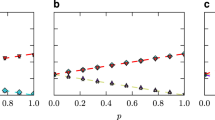Abstract
The control of quantum systems is of fundamental scientific interest and promises powerful applications and technologies. Impressive progress has been achieved in isolating quantum systems from the environment and coherently controlling their dynamics, as demonstrated by the creation and manipulation of entanglement in various physical systems. However, for open quantum systems, engineering the dynamics of many particles by a controlled coupling to an environment remains largely unexplored. Here we realize an experimental toolbox for simulating an open quantum system with up to five quantum bits (qubits). Using a quantum computing architecture with trapped ions, we combine multi-qubit gates with optical pumping to implement coherent operations and dissipative processes. We illustrate our ability to engineer the open-system dynamics through the dissipative preparation of entangled states, the simulation of coherent many-body spin interactions, and the quantum non-demolition measurement of multi-qubit observables. By adding controlled dissipation to coherent operations, this work offers novel prospects for open-system quantum simulation and computation.
This is a preview of subscription content, access via your institution
Access options
Subscribe to this journal
Receive 51 print issues and online access
$199.00 per year
only $3.90 per issue
Buy this article
- Purchase on Springer Link
- Instant access to full article PDF
Prices may be subject to local taxes which are calculated during checkout




Similar content being viewed by others
References
Ladd, T. D. et al. Quantum computers. Nature 464, 45–53 (2010)
Kimble, H. J. The quantum internet. Nature 453, 1023–1030 (2008)
Schoelkopf, R. J. & Girvin, S. M. Wiring up quantum systems. Nature 451, 664–669 (2008)
Neeley, M. et al. Generation of three-qubit entangled states using superconducting phase qubits. Nature 467, 570–573 (2010)
Saffman, M., Walker, T. G. & Mølmer, K. Quantum information with Rydberg atoms. Rev. Mod. Phys. 82, 2313–2363 (2010)
Bloch, I., Dalibard, J. & Zwerger, W. Many-body physics with ultracold gases. Rev. Mod. Phys. 80, 885–964 (2008)
O'Brien, J. L. Optical quantum computing. Science 318, 1567–1570 (2007)
Jones, J. A. Quantum computing with NMR. Preprint at 〈http://arXiv.org/abs/1011.1382〉 (2010)
Clarke, J. & Wilhelm, F. K. Superconducting quantum bits. Nature 453, 1031–1042 (2008)
Hanson, R., Kouwenhoven, L. P., Petta, J. R., Tarucha, S. & Vandersypen, L. M. K. Spins in few-electron quantum dots. Rev. Mod. Phys. 79, 1217–1265 (2007)
Wrachtrup, J. & Jelezko, F. Processing quantum information in diamond. J. Phys. Condens. Matter 18, S807–S824 (2006)
Feynman, R. Simulating physics with computers. Int. J. Theor. Phys. 21, 467–488 (1982)
Lloyd, S. Universal quantum simulators. Science 273, 1073–1078 (1996)
Buluta, I. & Nori, F. Quantum simulators. Science 326, 108–111 (2009)
Myatt, C. J. et al. Decoherence of quantum superpositions through coupling to engineered reservoirs. Nature 403, 269–273 (2000)
Viola, L. et al. Experimental realization of noiseless subsystems for quantum information processing. Science 293, 2059–2063 (2001)
Deléglise, S. et al. Reconstruction of nonclassical cavity field states with snapshots of their decoherence. Nature 455, 510–514 (2008)
Barreiro, J. T. et al. Experimental multiparticle entanglement dynamics induced by decoherence. Nature Phys. 6, 943–946 (2010); published online 26 September 2010.
Krauter, H. et al. Entanglement generated by dissipation. Preprint at 〈http://arXiv.org/abs/1006.4344〉 (2010)
Diehl, S. et al. Quantum states and phases in driven open quantum systems with cold atoms. Nature Phys. 4, 878–883 (2008)
Cho, J., Bose, S. & Kim, M. S. Optical pumping into many-body entanglement. Phys. Rev. Lett. 106, 020504 (2011)
Verstraete, F., Wolf, M. M. & Cirac, J. I. Quantum computation and quantum-state engineering driven by dissipation. Nature Phys. 5, 633–636 (2009)
Pastawski, F., Clemente, L. & Cirac, J. I. Quantum memories based on engineered dissipation. Preprint at 〈http://arXiv.org/abs/1010.2901〉 (2010)
Goldstein, G. et al. Environment-assisted precision measurement. Preprint at 〈http://arXiv.org/abs/1001.0089〉 (2010)
Lloyd, S. & Viola, L. Engineering quantum dynamics. Phys. Rev. A 65, 010101 (2001)
Häffner, H., Roos, C. F. & Blatt, R. Quantum computing with trapped ions. Phys. Rep. 469, 155–203 (2008)
Home, J. P. et al. Complete methods set for scalable ion trap quantum information processing. Science 325, 1227–1230 (2009)
Weimer, H., Müller, M., Lesanovsky, I., Zoller, P. & Büchler, H. P. A Rydberg quantum simulator. Nature Phys. 6, 382–388 (2010)
Bacon, D. et al. Universal simulation of Markovian quantum dynamics. Phys. Rev. A 64, 062302 (2001)
Kitaev, A. Y. Fault-tolerant quantum computation by anyons. Ann. Phys. 303, 2–30 (2003)
Nielsen, M. A. & Chuang, I. L. Quantum Computation and Quantum Information (Cambridge Univ. Press, 2000)
Steane, A. M. Efficient fault-tolerant quantum computing. Nature 399, 124–126 (1999)
Dür, W., Bremner, M. J. & Briegel, H. J. Quantum simulation of interacting high-dimensional systems: the influence of noise. Phys. Rev. A 78, 052325 (2008)
Wiseman, H. M. & Milburn, G. J. Quantum Measurement and Control (Cambridge Univ. Press, 2009)
Schmidt-Kaler, F. et al. How to realize a universal quantum gate with trapped ions. Appl. Phys. B 77, 789–796 (2003)
Mølmer, K. & Sørensen, A. Multiparticle entanglement of hot trapped ions. Phys. Rev. Lett. 82, 1835–1838 (1999)
Monz, T. et al. Coherence of large-scale entanglement. Preprint at 〈http://arXiv.org/abs/1009.6126〉 (2010)
Roos, C. F. et al. Control and measurement of three-qubit entangled states. Science 304, 1478–1480 (2004)
Gilchrist, A., Langford, N. K. & Nielsen, M. A. Distance measures to compare real and ideal quantum processes. Phys. Rev. A 71, 062310 (2005)
Jozsa, R. Fidelity for mixed quantum states. J. Mod. Opt. 41, 2315–2323 (1994)
Gühne, O. & Seevinck, M. Separability criteria for genuine multiparticle entanglement. N. J. Phys. 12, 053002 (2010)
Friedenauer, A., Schmitz, H., Glueckert, J., Porras, D. & Schaetz, T. Simulating a quantum magnet with trapped ions. Nature Phys. 4, 757–761 (2008)
Kim, K. et al. Quantum simulation of frustrated Ising spins with trapped ions. Nature 465, 590–593 (2010)
Porras, D. & Cirac, J. I. Effective quantum spin systems with trapped ions. Phys. Rev. Lett. 92, 207901 (2004)
Nayak, C., Simon, S. H., Stern, A., Freedman, M. & Das Sarma, S. Non-abelian anyons and topological quantum computation. Rev. Mod. Phys. 80, 1083–1159 (2008)
Ralph, T. C., Bartlett, S. D., O'Brien, J. L., Pryde, G. J. & Wiseman, H. M. Quantum nondemolition measurements for quantum information. Phys. Rev. A 73, 012113 (2006)
Riebe, M. et al. Deterministic entanglement swapping with an ion-trap quantum computer. Nature Phys. 4, 839–842 (2008)
Fleming, G. R., Huelga, S. & Plenio, M. (eds). New J. Phys. 12 (Focus on quantum effects and noise in biomolecules), (2010)
Acknowledgements
We thank K. Hammerer, I. Chuang, and O. Gühne for discussions and T. Northup for critically reading the manuscript. We acknowledge support by the Austrian Science Fund (FOQUS), the European Commission (AQUTE), the Institut für Quanteninformation GmbH, and a Marie Curie International Incoming Fellowship within the 7th European Community Framework Programme.
Author information
Authors and Affiliations
Contributions
M.M. and J.T.B. developed the research, based on theoretical ideas proposed originally by P.Z.; J.T.B., P.S. and D.N. performed the experiments; J.T.B., P.S. and T.M. analysed the data; P.S., J.T.B., D.N., T.M., M.C., M.H. and R.B. contributed to the experimental set-up; M.M., J.T.B. and P.Z. wrote the manuscript, with revisions provided by C.F.R.; all authors contributed to the discussion of the results and manuscript.
Corresponding authors
Ethics declarations
Competing interests
The authors declare no competing financial interests.
Supplementary information
Supplementary Information
The file contains Supplementary Text and Data, Supplementary Figures 1-11 with legends, Supplementary Tables 1-4 and additional references. (PDF 1862 kb)
Rights and permissions
About this article
Cite this article
Barreiro, J., Müller, M., Schindler, P. et al. An open-system quantum simulator with trapped ions. Nature 470, 486–491 (2011). https://doi.org/10.1038/nature09801
Received:
Accepted:
Published:
Issue Date:
DOI: https://doi.org/10.1038/nature09801
This article is cited by
-
Multi-dimensional band structure spectroscopy in the synthetic frequency dimension
Light: Science & Applications (2023)
-
Spin transport in non-Hermitian quantum systems
Scientific Reports (2023)
-
Non-Abelian effects in dissipative photonic topological lattices
Nature Communications (2023)
-
Theoretical investigation of dynamics and concurrence of entangled \({{\mathcal {P}}}{{\mathcal {T}}}\) and anti-\({{\mathcal {P}}}{{\mathcal {T}}}\) symmetric polarized photons
Scientific Reports (2023)
-
Engineered dissipation for quantum information science
Nature Reviews Physics (2022)
Comments
By submitting a comment you agree to abide by our Terms and Community Guidelines. If you find something abusive or that does not comply with our terms or guidelines please flag it as inappropriate.



